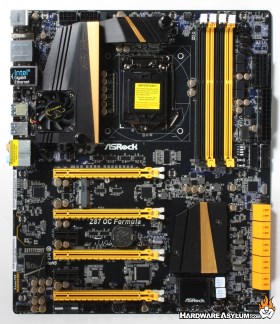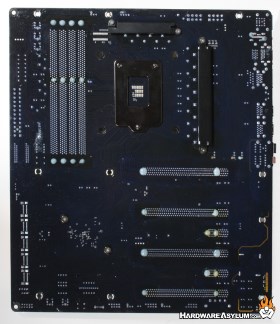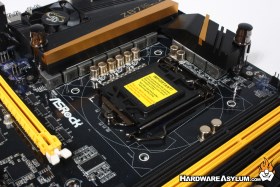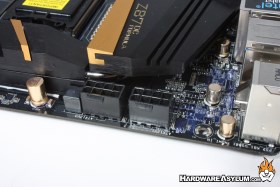ASRock Z87 OC Formula Overclocking Motherboard Review
Author: Dennis Garcia
Published: Monday, August 19, 2013
Board Layout and Features
The ASRock OC Formula features a black PCB with yellow and gold accents. It is difficult to tell if the PCB is matte of gloss given the conformal coating and since that coating will never come off it really doesn't matter.
You'll notice that the expansion slots follow a yellow theme with white paddles for the card locks. Gold accents can be found all over the OC Formula starting with the caps and extending to the VRM and MCP heatsinks.
You'll notice that the expansion slots follow a yellow theme with white paddles for the card locks. Gold accents can be found all over the OC Formula starting with the caps and extending to the VRM and MCP heatsinks.
Flipping a motherboard over can tell you a lot about its construction, to a certain degree. We can see that the back of the motherboard is virtually devoid of any surface components aside from two VRM heatspreaders and a CPU reinforcement bracket. Unlike some of the other motherboards we have reviewed each 16x PCI Express slot has been wired the entire length so it will be difficult to know eaxatly how many lanes each slot has without testing them.
One thing you may notice is the rather large white dots at around the expansion slots. Normally this is where the plastic tabs pass thru the PCB during the assembly process. It would seem that as part of the conformal process they have decided to seal these voids in what appears to be hot glue.
One thing you may notice is the rather large white dots at around the expansion slots. Normally this is where the plastic tabs pass thru the PCB during the assembly process. It would seem that as part of the conformal process they have decided to seal these voids in what appears to be hot glue.
Moving towards the CPU socket we can see dark chrome retention hardware surrounded by a 12-phase VRM and handful of gold caps. At 12 phases this might be one of the smallest VRM designs we have seen on an overclocking motherboard but, as they say its not so much the size as the quality of the components.
Behind the PWM cooler you will find two 8-pin 12v CPU power connectors that will feed power directly into the processor. Most overclocking motherboards are somewhat light when it comes to supplying power to the CPU and while a single 8-pin is recommended by Intel having a secondary plug is added insurance under extreme overclocking conditions.
Behind the PWM cooler you will find two 8-pin 12v CPU power connectors that will feed power directly into the processor. Most overclocking motherboards are somewhat light when it comes to supplying power to the CPU and while a single 8-pin is recommended by Intel having a secondary plug is added insurance under extreme overclocking conditions.
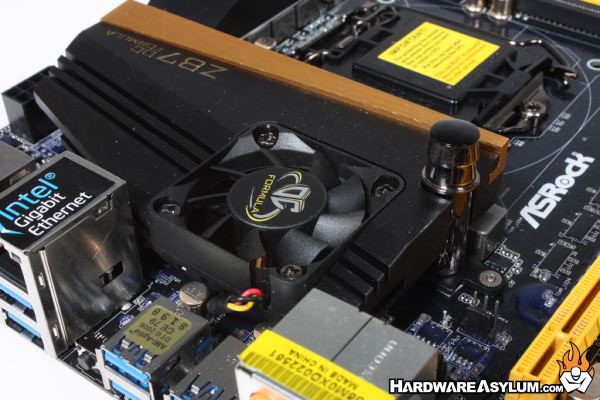
The ASRock VRM is cooled by a very fancy heatsink that combines a few key cooling technologies. As the photos show the heatsink is quite large and wraps around both sides of the VRM. There is a single cooling fan providing active cooling along with a water loop. Both of these are important when watercooling since the movement of air is hindered once the CPU fan has been removed. This also extends to using extreme cooling. While some would say the LN2 should cool the VRM that isn't always the case.

